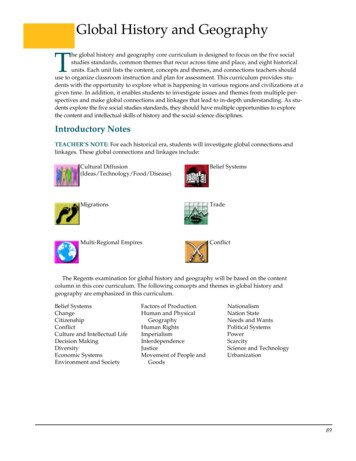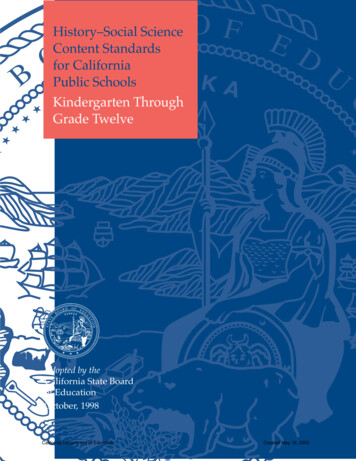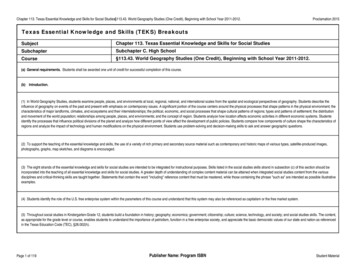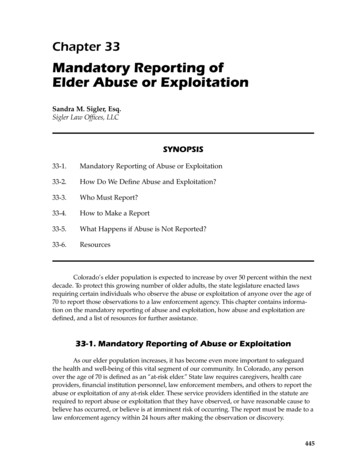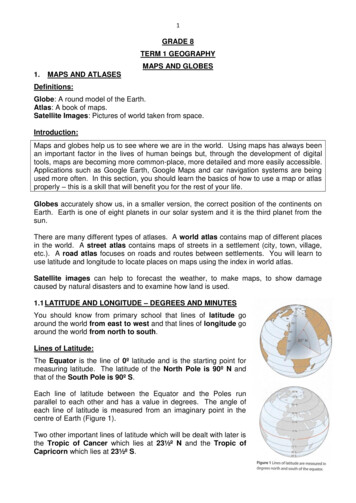
Transcription
1GRADE 8TERM 1 GEOGRAPHYMAPS AND GLOBES1.MAPS AND ATLASESDefinitions:Globe: A round model of the Earth.Atlas: A book of maps.Satellite Images: Pictures of world taken from space.Introduction:Maps and globes help us to see where we are in the world. Using maps has always beenan important factor in the lives of human beings but, through the development of digitaltools, maps are becoming more common-place, more detailed and more easily accessible.Applications such as Google Earth, Google Maps and car navigation systems are beingused more often. In this section, you should learn the basics of how to use a map or atlasproperly – this is a skill that will benefit you for the rest of your life.Globes accurately show us, in a smaller version, the correct position of the continents onEarth. Earth is one of eight planets in our solar system and it is the third planet from thesun.There are many different types of atlases. A world atlas contains map of different placesin the world. A street atlas contains maps of streets in a settlement (city, town, village,etc.). A road atlas focuses on roads and routes between settlements. You will learn touse latitude and longitude to locate places on maps using the index in world atlas.Satellite images can help to forecast the weather, to make maps, to show damagecaused by natural disasters and to examine how land is used.1.1 LATITUDE AND LONGITUDE – DEGREES AND MINUTESYou should know from primary school that lines of latitude goaround the world from east to west and that lines of longitude goaround the world from north to south.Lines of Latitude:The Equator is the line of 0º latitude and is the starting point formeasuring latitude. The latitude of the North Pole is 90º N andthat of the South Pole is 90º S.Each line of latitude between the Equator and the Poles runparallel to each other and has a value in degrees. The angle ofeach line of latitude is measured from an imaginary point in thecentre of Earth (Figure 1).Two other important lines of latitude which will be dealt with later isthe Tropic of Cancer which lies at 23½º N and the Tropic ofCapricorn which lies at 23½º S.
2Lines of Longitude:Lines of longitude run through both the Northand South Poles. They are not parallel lines.They are often referred to as meridians. Earthis divided equally into 360º of longitudeThe most important line of longitude is theGreenwich Meridian. This is the meridian fromwhere the world time zones are calculated.The Greenwich Meridian is also called thePrime Meridian and is the 0º line oflongitude.The Earth is therefore divided into different hemispheres. Places North and South of theEquator and places East and West of the Greenwich Meridian. America, for example, isNorth of the Equator but West of Greenwich.In which two hemispheres is South Africa?Degrees and Minutes:Lines of latitude and longitude on maps and globes make it easier to find places. Each line of latitude and longitude has a value in degrees. A degree of longitude at the equator covers about 111 km. One degree of latitude also covers about 111 km. Each degree of latitude and longitude can be divided into 60 minutes.By using degrees and minutes, we can pinpoint places to within less than 2 km ofaccuracy. We do not show minutes on most maps because this would cover the map withtoo many lines. We usually need to estimate where the lines will be.ACTIVITY 1Study Figure 3 on page 4 and state the latitude and longitude of the places numbered 1-7.Write your answers in the spaces below.(7)1.2.3.4.5.6.7.
31.2 USING THE ATLAS INDEX TO FIND PLACES ON A MAP:At the back of an atlas, you will find the atlas index. A good atlas index lists most of theplace names in the atlas. The names are in alphabetical order. Next to each place nameare the latitude and longitude coordinates in degrees and minutes.How to use the index of an atlas:a) Look up the name of the place you want to find in the index. Go to the correct partof the alphabetical index: for example Port Elizabeth is in the P section.b) Write down the coordinates that are next to the name Port Elizabeth – 33º55’ S,25º25’ E.c) Go to the correct page in the atlas indicated in the index, e.g. page 42.d) Look for 33 and 34 degree lines of latitude.e) Because minutes are not marked on maps, you have to estimate where 55 minuteswill be. You will have to estimate that this will be between the 33 and 34 degreelines of latitude. Fifty-five minutes is almost 60 minutes. Sixty minutes is onedegree. You can see that the 33º55’ line of latitude is very close to the 34º line oflatitude.f) Now estimate Port Elizabeth’s longitude position - 25º35’ E. Because you knowthat there are 60 minutes in a degree, you know that there will be 30 minutes in halfa degree. So, 35 minutes will be just over half way between 25º and 26º east.NB: Give the degrees first and then the minutes. Start with latitude (S) first andthen longitude (E)
4ACTIVITY 3:Study the grid below (Figure 4) and answer the following questions.Example:The latitude position of point A is 21 30’ SThe longitude position of point A on the above grid is 29 10’ E.When we combine these latitude and longitude position of a place, we are giving theircoordinates. Therefore the coordinates of Point A are 21 30’S 29 10’E.NB: Always give the latitude position before the longitude position.Because South Africa is in the Southern and Eastern Hemispheres of the Earth, we followthe ‘Down Right’ rule () – latitude (South – down) first and longitude (East – right)second.Now give the coordinates for the letters B, C, D, E and F in Figure 4 above. Write youranswers in the space below. One mark for the correct latitude and one for the correctlongitude.(10)B.C.D.E.F.
51.3 KINDS OF SCALES – WORLD, REGIONAL AND LOCALScale: a way of accurately representing objects smaller than their real size.Not all maps in an atlas are drawn to the same scale. The scales are different becausethe maps how different sizes of land. For example, some maps show the whole world.Others show only a province or a country. The size of the area covered by the mapinfluences the map scale.The larger the area covered by the map, the smaller the map scale.1.4 DIFFERENT WAYS OF SHOWING SCALES ON A MAP:a) Word/Statement Scale:This tells you what the scale of the map is in a sentence, e.g. One centimetre on themap represents fifty thousand centimetres on the ground (in reality ½ akilometre).b) Line/Linear Scale:This is a straight line at the bottom of the map. The line is divided into subsectionsthat show the length on the ground of a distance shown on the map.c) Ratio/Representative Scale:This shows scale in the form of a ratio, e.g. 1: 50 000.Both amounts in the ratio are the same unit (cm). So the ratio scale 1:50 000 meansthat 1 cm on the map represents 50 000 cm on the ground. The smaller the ratio, themore detail the map shows.Calculating Distance on a Map:Distance on a map is calculated between two specific points, for example the distancebetween a school and a bus stop. The two points are joined with a line as in the case of ‘A’ above.Measure the length of A using a rule with clearly marked cm or mm units.Write down the reading you got after measuring line A, e.g. 4 cm.Check the scale of the map on which the school and the bus stop are shown. InSouth Africa, in schools, we usually use the 1:50 000 ratio scale.This means that 1 cm on the map is equal to ½ a kilometre in reality.Take the 4 cm that you measured and divide by 2. (4 2 2 km).Please note that your answer needs to be converted into the units of distance inreality. 4 cm on the map at a scale of 1:50 000 equals 2 km in reality.
6Sometimes distance can be calculated along a winding river or path. It is difficult to dowith a rigid ruler, but it can be done by using a piece of string. You place the string alongthe winding object and afterwards stretch it out along the units of your ruler. You thencalculate the distance as shown in the previous steps.2.THE GLOBE2.1 HEMISPHERESThe world has four hemispheres: The Equator divides the earth into the northern and southern hemispheres. The Greenwich Meridian and 180 line of longitude also divide the world into theeastern and western hemispheres.2.2 THE EARTH’S ROTATION ON ITS AXIS – DAY AND NIGHT The earth tilts on its axis at an angle of 23½ . The earth rotates on its axis – we know this because the position of the sun in thesky changes during a day. The earth takes 24 hours to complete one 360 rotation. During 24 hours, different places on the earth move into the sun’s rays. It rotates from west to east or anticlockwise.
72.3 WORLD TIME, TIME ZONES AND THE INTERNATIONAL DATE LINE.Earth is constantly moving in and out of the sun’s rays. The sun appears to move acrossthe sky from sunrise to sunset, but we know that it is Earth that is moving – not the sun.We measure time against the position of the sun. When it is midday in South Africa, it isalready midnight in New Zealand. The Earth’s rotation on its axis means that timechanges by one hour for every 15 of longitude.The eastern hemisphere will always be ahead of Central Africa Time (CAT) andexperiencing a later time in the day. The western hemisphere will always be behind CATand experiencing an earlier time in the day.Each country calculates their time according to their time zone. All time is calculated inrelation to the time at Greenwich Meridian. In theory, the world’s time zones shouldchange by 1 hour for every 15 of longitude, but Governments of countries adjust timezones to fit into the borders of their country. Time zones are also adjusted to fit aroundinternal borders such as states or provinces.Large countries like the United States of America and Australia have several time zones.The Chinese government decided that China should only have one time zone even thoughthe longitude position of China means that it should have four time zones.
8The International Date Line:This line of longitude is on the opposite side of the world to the Greenwich Meridian. Itfollows the 180 line of longitude for most of its length. Like the other time zones, theInternational Date Line is adjusted to go around certain islands and countries. TheInternational Date Line divides the world into the eastern and western hemispheres on thePacific Ocean part of the world. Places in the eastern hemisphere are a day earlier thanplaces in the western hemisphere.Tonga and American Samoa have the same time, but are one day apart. This is becauseAmerican Samoa is in the Western Hemisphere, on the opposite side of the InternationalDate Line from Tonga.2.4 SOUTH AFRICAN STANDARD TIMESouth Africa should have two time zones because both the 15 and 30 lines of longitudepass through the country. The South African government decided to adjust the time zonesto fit its borders. South African Standard Time is based on the 30 line of longitude. It istwo hours ahead of the time on the Greenwich Meridian.
9ACTIVITY 4: You need access to an atlas or a wall map.1.Using the ratio scale 1:50 000, calculate the following distances.spaces provided and show calculations.Answer in thea) 8 cm on the map is in reality.b) 5, 5 cm on the map is in reality.c)9, 5 cm on the map is in reality.Answers:a)b)c)2. Rewrite the ratio scale 1:50 000 as a word scale.3.4.In to which of two of earth’s hemispheres will you find the following places?E.g.: South Africa:South EastRussia:Egypt:Portugal:Canada:Use the time zones on page 7 to help you answer the following questions.a) Is it earlier or later to the east of the Meridian?b) What time will it be in South Africa if it is 12 noon at Greenwich?c) When it is 8 am in Western Australia, what time is it in South Africa?d) If your friend phones you at midnight in Japan, what time will it be in South Africa?5.What line of longitude does the IDL follow?6.Look at the diagram of the IDL on page 8 of your notes. How many degrees oflongitude has the IDL been adjusted where is it 5 south of the equator? Why was thisadjustment made?Explain why Tonga and American Samoa have the same time, but a different date?7.
102.5 THE EARTH’S REVOLUTION AROUND THE SUNAngle of AxisThe Earth rotates on its axis which is always at an angle of 23, 5 . The tilt of theEarth’s axis is maintained for the 365, 25 days it takes to complete one orbit in itsrevolution around the sun. This takes one year.It takes the earth 365, 25 days to make one revolution around the sun. We drop the, 25(¼) of a, day from our calendar but every four years, we make up for it by adding onefull day to the month of February. This is called a Leap Year. February has 29 daysin a Leap Year.The angle of axis and the orbit causes the northern hemisphere to be tilted towards thesun when the southern hemisphere is tilted away from the sun. The opposite occurs sixmonths later when the northern hemisphere is tilted away from the sun.EQUINOX, SOLSTICE AND THE CHANGE OF ANGLE IN THE MIDDAY SUNThe Earth’s revolution around the sun and the tilt of its axis makes it appear as though thesun is moving between the tropics. Each tropic is the farthest boundary, north and south,where the sun can be directly overhead at noon, at different times of the year.An equinox occurs when the sun’s rays shine directly over the Equator at noon. Becauseof the Earth’s revolution around the sun, this occurs twice a year – 21 or 22 March and 22or 23 September. On these days, every place in the world receives an equal amount ofdaylight and darkness (12 hours of daylight and 12 hours of darkness).
11A solstice occurs when the sun’s rays are directly over the tropics at noon. This happenstwice a year – on 21 or 22 June and 21 or 22 December.The summer solstice for the southern hemisphere is on 21 or 22 December. This iswhen the sun reaches its furthest point south, shining directly over the Tropic ofCapricorn at noon. The southern hemisphere receives the longest hours of sunshine.Within the Antarctic Circle the sun never sets but shines for 24 hours.South Africa has its winter solstice on 21 or 22 June, when the sun is at its furthestpoint away, shining directly over the Topic of Cancer in the north at noon. The southernhemisphere has the shortest hours of sunshine, while the northern hemisphere has thelongest hours of sunshine. Within the Arctic Circle the sun never sets and it is light for24 hours.When the southern hemisphere has its summer solstice, the northern hemispherehas its winter solstice.Oceans take longer to warm up and cool down than the land does. That is why the hottestsummer temperatures for South Africa are not on 21 or 22 December (the summersolstice), but in January and February of the following year.SEASONAL CHANGES IN LENGTH OF DAY AND NIGHTThere are four seasons in a year and each season lasts approximately three months. Inreality there is no sudden change where one season ends and another begins.In the southern hemisphere, the sun shines directly over the Tropic of Capricorn on 21 or22 December. This is the furthest point south on Earth on which the sun’s rays can shinedirectly. The longest hours of sunlight are experienced in the high latitudes of thesouth because the southern hemisphere is tilted towards the sun.As the sun moves further north back towards the Equator, the days become shorter.By 21 or 22 March, the sun is directly over the Equator and all places on earth receive 12hours of daylight and 12 hours of darkness. This is autumn in the southernhemisphere.
12Winter follows autumn as the sun moves even further north and shines directly over theTropic of Cancer on 21 or 22 June. This is the winter solstice for the southernhemisphere and the summer solstice for the northern hemisphere. The days are theshortest and the nights are the longest in the south because the south is tilted awayfrom the sun.As the sun moves southwards again, the days begin to grow longer. When the sun is backover the Equator, on 22 or 23 September, the spring equinox occurs for the southernhemisphere. When the sun is directly over the Tropic of Capricorn on 21 or 22December, it is the summer solstice in the southern hemisphere.SEASONAL TEMPERATURE CHANGESTemperatures on Earth are controlled by how much insolation the Earth receives. Theamount of insolation is greatest during the summer solstice and least at the time of wintersolstice.Insolation: the amount of heat and light that enters the Earth’s atmosphere from the sun.Insolation is greatest over the over the Equator and between the tropics. Here, thesun has less atmosphere to shine through and the rays are directly focused. Less heat islost getting to the Earth’s surface. This is why it is so warm at the Equator and in thetropics all year round.Insolation is least in the high latitudes near the Poles. The angle at which the sun’srays strike the Earth is greater and this spreads the heat over a wider area making it lessintense. Heat is lost because the sun’s rays must travel through more atmosphere toreach the Earth’s surface.
133. SATELLITE IMAGES3.1 What do satellite images look like?A satellite is a highly complex piece of technology which is positioned above Earth inspace. Sensors on the satellite collect information about Earth and send it back tosatellite-receiving stations on the ground. The information is used to make different kindsof satellite images.Satellite images are not photographs. The images are made from a collection of dataobtained by sensors on the satellite. The satellite sends information to receiving centreson the ground. Computers process this data and produce different images that we canview and interpret.Satellite Image of Cape Town taken in 2010.3.2 Information from Satellites Images:Satellite images have many applications: mapping, weather forecasting and cloudpatterns, land use, agriculture, geology, vegetation studies and forestry, biodiversity,conservation, regional planning, education, intelligence and warfare. It is also used inseismology and oceanography in deducing changes to land formations, water depth andsea bed, changes by earthquakes, volcanoes and tsunamis. Often a series of satelliteimages can be put together to make a composite image.3.3 How Satellite Images are used:Satellite images help scientists identify areas where there is water and vegetation and ifrocks contain valuable resources such as oil, iron and gas deposits, as well as providinginformation about approaching cloud patterns and storms. All of these uses can takeplace from examining satellite images without people having to actually visit the areas inquestion.
14One of the most common uses of satellites is in weather forecasting. Weather satellitesprovide information about the position and types of clouds in the atmosphere, windspeeds, pressure differences and temperature. A weather satellite can supply regularinformation about how conditions in the atmosphere change over a short time. A trainedmeteorologist can interpret a weather satellite image and make informed predictions aboutwhat the weather will be like in different places. Cloud patterns provide information aboutapproaching rain or snow storms. This information can help people prepare for what couldbe a natural disaster.Satellite image of a hurricane off the Florida Coast, USA.
1 GRADE 8 TERM 1 GEOGRAPHY MAPS AND GLOBES 1. MAPS AND ATLASES Definitions: Globe: A round model of the Earth. Atlas: A book of maps. Satellite Images: Pictures of world taken from space. Introduction: Maps and globes h
